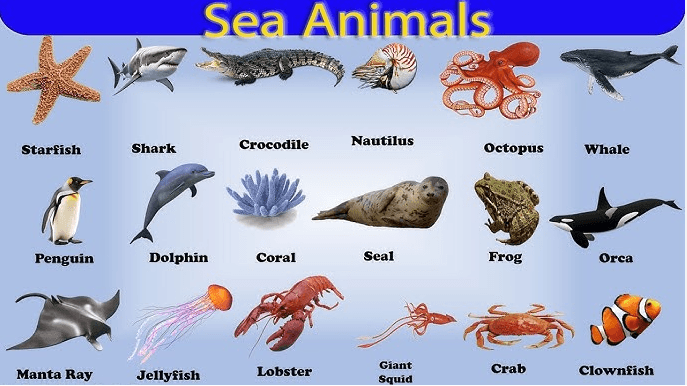The list of the most dangerous sea creatures might shock you! Because sharks aren’t the only hazardous marine animals. From the Australian box jellyfish to the Portuguese man of war, discover 15 venomous sea animals.
The ocean, which seems beautiful and soothing, can be a dangerous place for you. An undefined number of sea creatures, including reptiles, fishes, crustaceans, and cnidarians, are waiting for some prey! These tiny to large organisms have the power to cause serious injury or even death in some cases.
One quick fact: Don’t let the size betray you. Though strength is important, even the tiniest sea creature can be dangerous for you! So, buckle up, and let’s uncover the most dangerous sea creatures in the world.
15 Dangerous Sea Creatures:
- Australian Box Jellyfish
- Irukandji Box Jellyfish
- Beaked Sea Snake
- Flower Urchin
- Cone Snail
- Striped Pyjama Squid
- Stonefish
- Dubois’ Sea Snake
- Blue-ringed Octopus
- Puffer Fish
- Stingray
- Saltwater Crocodiles
- Great Water Shark
- Lionfish
- Portuguese Man of War
Most Dangerous Animal in the Ocean:
Australian Box Jellyfish:
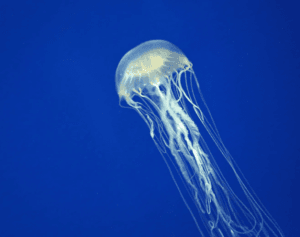
Australian Box Jellyfish
Starting the list with the most dangerous sea creatures to humans. As the name implies, this box jellyfish lives in Australia and Southeast Asia.
The Australian box jellyfish has a length of 10 feet long and has transparent bells that are 12 inches long. It has specialized cells called nematocysts. Australian box jellyfish is a venomous sea creature that injects its venom through nematocysts.
The stings of Australian box jellyfish are excruciating. Unfortunately, if venom is injected in large amounts, it can cause paralysis and heart failure in minutes.
Death Record: According to the available data, they have killed more than 70 people in the last century.
Irukandji Box Jellyfish:
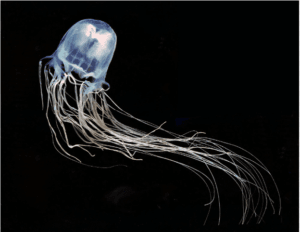
Irukandji Box Jellyfish
Ever heard the word Irukandji Syndrome? It’s caused by the deadliest Irukandji box jellyfish. It’s known as Irukandji because of its origin; it came from the aboriginal people in the Cairns area of Australia, where the box jellyfish occur frequently.
Compared to American box jellyfish, the Irukandji box jellyfish is very small. It grows to only 0.8 inches and has only four tentacles. It captures its prey with a mighty punch. It’s also venomous.
The sting of Irukandji box jellyfish isn’t that strong, but severe symptoms occur after 20 to 40 minutes. The symptoms include extreme pain, muscular cramps, high heart rate, hypertension, and fluid in the lungs, ultimately leading to life-threatening cardiac complications.
Death Records: In Australia, 50-100 cases of Irukandji Syndrome are reported annually.
Beaked Sea Snake:
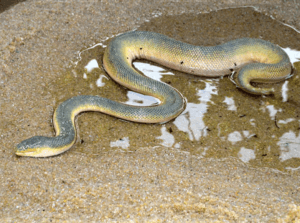
Beaked Sea Snake
The venom of a beaked sea snake is more potent than that of a Cobra. It’s one of the most dangerous sea creatures.
The beaked sea snake is also known as hook-nosed sea snake or Valakadyn sea snake. It’s found in the sea and freshwater. It can grow to 3.9 feet long.
Death Records: Beaked sea snakes are responsible for half of the sea snake bites in the Malay Peninsula.
Flower Urchin:
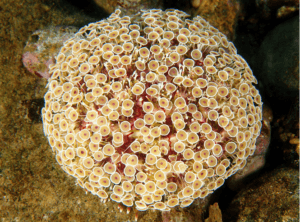
Flower Urchin
Flower urchin has been designated as one of the most dangerous sea creatures in the world by Guinness World Records. It’s found in seagrass, coral reefs, rocky and sandy environments of the Indo-West Pacific.
Flower urchin is a venomous sea creature that is deadly to humans. Its venom is present in its spine and appendages. The symptoms after the sting of the flower urchin are difficulties in respiration, severe pain, and paralysis.
Cone Snail:
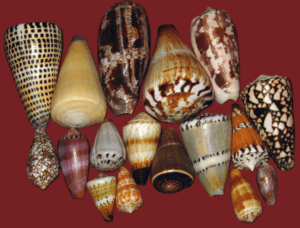
Cone Snail
Cone snails have more than 1000 species. The spices vary in size and shape. The cone snails have conical-shaped shells. Cone snails belong to Mollusca.
The cone snails are predatory and venomous. It’s one of the most dangerous sea creatures in the world. They have harpoon-like modified teeth filled with venom. They use these teeth to paralyze their prey, usually small fish, invertebrates, and other small cone snails. The venom of a cone snail is highly poisonous, as it has more than 10000 active components. A single sting of a cone snail can cause respiratory paralysis, resulting in death.
Death Records: Geography cone snails have caused 15 deaths in the last 30 years.
Striped Pyjama Squid:
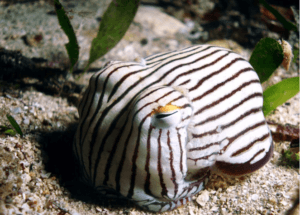
Striped Pyjama Squid
Oops! This one of the most dangerous sea creatures is as weird as its name. But it’s not only weird but also poisonous and venomous.
Striped pyjama squid is a dapper cephalopod. It injects its venom by its bite. The venom contains a neurotoxin known as tetrodotoxin. If that poisonous neurotoxin wasn’t enough, the striped squid also produces poisonous slime to deter predators!
Though named as squid, they are actually cuttlefish. They are found in Australia and grow to only two inches long. The striped pyjama squid is also known as the striped dumpling squid.
Stonefish:

Stonefish
Stone is one of the most dangerous sea creatures in the world. It’s dangerous not only because of its venom but also because its camouflage properties can betray naive prey. It hides and camouflages itself in the coastal reefs in the India and Pacific ocean.
The dorsal spine of stonefish contains venom that is released under pressure. For example, if you step on a stonefish, accidentally considering it a stone, but it is actually a stonefish camouflaged on a stone, it will release venom to protect itself and capture its prey.
When the venom of stonefish is injected into humans, it can cause serious pain and swelling.
Stonefish can cause two clinical scenarios. The mild ones require a short hospital stay, while the extreme cases can cause respiratory failure, conclusions, heart attack, and ultimately death.
Death Records: In 2018, a boy died from the sting of a stonefish because of pulmonary edema.
Dubois’ Sea Snake:
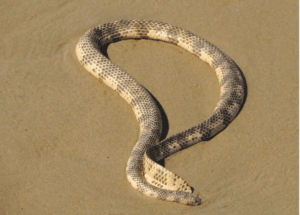
Dubois’ Sea Snake
Dubois’ Sea Snake is one of the 60 species of snake. It’s not only the most dangerous sea creature but also the most venomous marine snake in the world. It’s also one of the top three most venomous snakes in the world.
It’s found in Australia, Papua New Guinea, and New Caledonia. The Dubois sea snake is also known as the reef shallow snake. Its bite is mild because of its tiny fangs, but the venom can cause nausea, diarrhea, dizziness, convulsions, and ultimately collapse.
Blue-ringed Octopus:
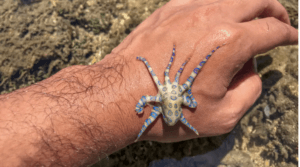
Blue-ringed Octopus
Blue-ringed octopuses are one of the most dangerous octopuses in the sea. Don’t be deceived by its beautiful stripes or small size. It belongs to the Pacific and Indian Oceans.
The blue-ringed octopus also produces tetrodotoxin. A poisonous toxin that rapidly causes paralysis with other life-threatening consequences.
Puffer Fish:

Puffer Fish
Pufferfish is one of the most dangerous sea creatures, yet its meat is one of the most delicacies in Japan. Pufferfish is one of the most toxic sea creatures in the world. It feeds on bacteria, and its organs and skin accumulate tetrodotoxin.
The Japanese Pufferfish is well known because it’s commercially farmed for human consumption in Japan, as already described. But, it’s not a job for every chef because if incorrectly prepared, it can lead to death.
Death Record: Nearly 50 people die from pufferfish poisoning in Japan annually.
Stingray:

Stingray
Stingray is a naive yet one of the most dangerous sea creatures in the world. It’s unlikely that you got attacked by this species. Because it spends most of its day buried in the seabed or gliding along the ocean.
It only injures those people who accidentally hurt or threaten it. The danger comes in the form of venomous barbs along their tail. The stingray whips its tail when threatened. It’s a form of deference for the animal, but if you provoked it further, then it would be your luck.
Saltwater Crocodiles:
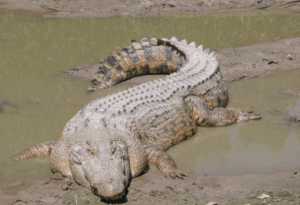
Saltwater Crocodiles
Saltwater crocodiles aren’t only the most dangerous sea creatures in the world but also the largest reptile on Earth. It can grow to 7 cm long and weighs 1000 kilograms.
Do you know the animal with the most substantial bite? It’s not the Cheetah, leopard, or shark but a saltwater crocodile. They are known for their aggressive nature when defending their territory.
Death Record: In Queensland, Australia, there were 47 attacks of saltwater crocodiles on humans between 1985 and July 2023. Out of these 47 bites, 13 resulted in a fatality.
Great Water Shark:
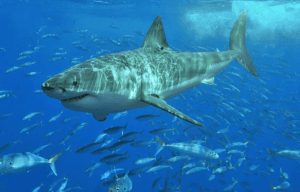
Great Water Shark
The great water shark is known as one of the most dangerous sea creatures, but does this shark deserve this recognition? A study suggests that out of the 949 confirmed unprovoked attacks by sharks on humans in history, only 351 were caused by excellent water sharks, and only 59 out of these 351 resulted in human deaths. Though for us, it’s a big number. A single human life is very important, and 59 is a big number, but we’re currently discussing it from the perspective of the most dangerous sea creature!
Next to great water sharks are tiger and bull sharks. These sharks are able to cause maximum damage because of their huge sizes.
Great water sharks can grow up to 6 meters long and weigh 1800 kg. Their teeth have evolved for tearing. They are commonly found on tropical coastlines.
Death Records: The number of unprovoked attacks by sharks annually is very small. There were only 108 in 2022. Out of these, 108,32 bites resulted from a situation where the great water shark was harassed by divers or predators. Only 9 shark-related deaths were reported out of these 108 cases.
Lionfish:
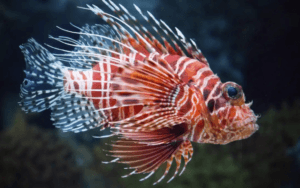
Lionfish
The red lionfish is one of the most beautiful but most dangerous sea creatures in the world. They have elegant red and white stripes, fan-like fins and dorsal spines, and overall a marvel of nature. Lionfish are native to the South Pacific, Indian Oceans, and the Caribbean and Southeast US coasts.
It’s venomous and can cause nausea, vomiting, breathing difficulties, and paralysis in humans. The red lionfish generally prey on native fishes and, luckily, has no predators. So, the chefs of Florida are trying to promote lionfish as a snack in an attempt to control its population because it has no predators and can reproduce all year round. Thirdly, it’s scientifically proven that a mature female lionfish can produce 2 million eggs annually. Hence, it’s important to keep its population in check.
Death Records: The lionfish rarely cause death.
Portuguese Man o’ War:
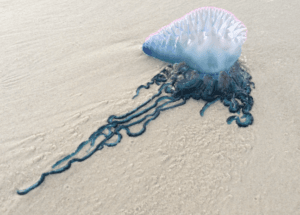
Portuguese Man of War
Don’t confuse jellyfish with Portuguese Man o’ War. It’s actually a venomous siphonophore. Siphonophore is a colony made up of specialized individuals known as zooids. The zooids work together as one unit.
Portuguese Man o’ War has the following body parts: polyps, bladder, tentacles, digestive and reproductive system.
Ever wondered why this dangerous sea creature is named Man o’ War? The uppermost polyp forms a gas-filled bladder that’s blue or purple. This bladder sits above the water. And the species got its name because it’s thought to resemble an old warship.
The Portuguese Man o’ War has 30-foot-long stinging tentacles that are used to catch and paralyze prey. The sting is responsible for causing fever and shock in humans.
Death Record: Deaths caused by the Portuguese Man o’ War have been recorded, but the cases are low.
What is the Most Dangerous Sea?
The black sea is the most dangerous sea in the world due to its unexpected weather patterns, strong winds, and navigational hazards.
Conclusion:
Most dangerous sea creatures in the world range from the venomous Australian Box Jellyfish to the Portuguese Man o’ War. Happy reading.
